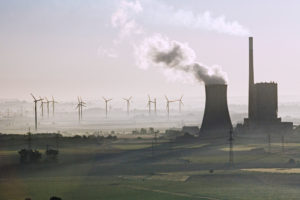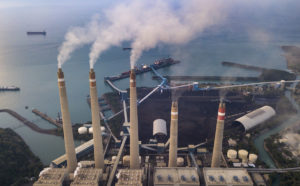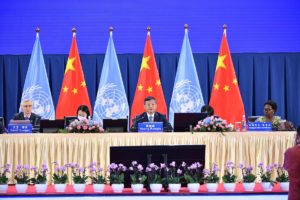Mounting evidence from across the globe shows that coal has had its day. The most polluting fossil fuel is not only bad for the climate and public health, but is also becoming financially unviable as renewable energy prices plummet. And yet, together with oil, it still dominates the world’s energy mix. Coal still plays a major role in energy production and remains a major energy source in many Asian countries like China, India and Indonesia, as well as many other parts of the world.
Now, a range of financial institutions in Asia and beyond are looking to buy out coal assets to hasten its phase-out. But experts still question whether the idea has what it takes to catalyse a deep and just energy transition.
Running out of time to phase out coal
In the latest report by the UN Intergovernmental Panel on Climate Change (IPCC), scientists made it clear once again that a deep decarbonisation of the world’s economy is essential to avoid the worst consequences of global warming. But markets alone do not seem to be able to displace coal fast enough.
“There is a general narrative that the transition beyond coal is inevitable, and that it’s only a matter of time,” says Justin Guay, director of global climate strategy at the Sunrise Project, a social enterprise. “But that’s only partially true.” Building new clean energy infrastructure is already cheaper than operating any old coal-fired power plant, he adds, so at least on paper there should be virtually no hurdles to a fast energy transition from fossil fuels.
Fossil fuel market distortions
However, “the reality is obviously much murkier, and much more difficult”, says Guay. All the economic pressures that would otherwise force coal plants to shut down because they are haemorrhaging money, “don’t matter when you receive public subsidies in a variety of forms”.
According to the think-tank Carbon Tracker Initiative, nearly 70% of the global coal fleet relies on what experts call market distortions, or policy decisions that help coal producers beat the competition.
Market distortions are unique to each country, explains Durand D’Souza, data scientist at Carbon Tracker Initiative. For example, in India long-term contracts bind energy distributors to coal producers, even if their energy becomes expensive, passing the costs on to the consumer or other actors in the supply chain. In China, “GDP targets were incentivised over keeping electricity prices down”, he explains, “and coal plants have been, for a long time, an easy route to raise GDP quickly through investment”.
Guay believes that despite the current market distortions, regulators and utilities will eventually realise that coal is a bad investment. “But the only variable that matters is time, we actually need to accelerate [the transition] dramatically,” he says.
To do so, stopping the construction of new coal facilities is not enough. Instead, experts are suggesting that existing plants should be retired before completing their life cycle. In the US, the environmental organisation Sierra Club has been running a successful campaign for coal retirement. The campaign has secured the retirement of 347 coal power plants across the country through advocacy and political pressure, with 183 left to target.
But phasing out coal in developing nations poses its own unique challenges, because communities are poorer and thus less able to adapt to change.
Asian Development Bank’s plan to retire coal early in Southeast Asia
To facilitate a rapid but just transition from the fossil fuel, some financial institutions and research organisations have been exploring ways to help coal-dependent developing nations decarbonise. Energy transition mechanisms (ETMs) are one financial instrument designed to enable nations to retire their coal assets early. They involve public and private actors working together with governments to assess specific economic and regulatory risks and deploy the right set of incentives to decommission or repurpose coal plants.
At COP26, the Manila-based Asian Development Bank (ADB) will introduce a plan it has designed in partnership with the UK insurer Prudential to identify a portfolio of coal power plants to buy and retire across Southeast Asia, with an initial budget of USD 4.05 million for the design phase.
The Asian Development Bank (ADB) is one of a group of financial institutions known as multilateral development banks set up as regional arms of the World Bank. Established in 1966, the ADB focuses on countries in the Asia Pacific region. It currently has 68 member countries, of which 49 are in the region. The ADB provides loans, technical assistance, grants and equity investments.
“ADB is finalising a pre-feasibility study – consisting of initial system-level analysis, plant-level modelling, and regulatory and policy review – in Indonesia, the Philippines, and Vietnam,” a spokesperson told The Third Pole. This will be followed by an in-depth feasibility analysis focused on Indonesia and the Philippines, the spokesperson said.
Promises and pitfalls
According to the think-tank Institute for Energy Economics and Financial Analysis (IEEFA), which last month published an analysis of the ADB’s initiative, COP26 is particularly significant because it is “finally driving a new round of policy work by the [multilateral development banks], and ADB is running hard to have a compelling solution on the table for donor nations to support”. The ADB, the analysts say, has an important role to play because donor nations have struggled to find fundable initiatives in markets such as the Philippines, Vietnam, Indonesia and Bangladesh, where the energy sector is growing fast.
Buying out coal plants may be a straightforward idea, but in practice it is a task fraught with complexities. Melissa Brown, a specialist in Asian energy finance with IEEFA and an author of the report, explains: “We know that these types of proposals are most likely to succeed in markets that […] are subject to competition” – and that could be a problem for the ADB. “In Indonesia, in Vietnam, the vast majority of the power capacity is controlled by vertically integrated state-owned enterprises,” which control the entire supply chain. This means it will be hard to target players who may own old, high-emissions systems that are beginning to fear the competition and worry they may run out of business, she says.
Others believe that the astronomical cost of scaling up retirement of this fossil fuel is not worth it. Funding the buyout of one large coal-fired plant with a capacity of around 1GW would cost USD 1 billion. To retire half of the coal fleet in Indonesia, the Philippines and Vietnam, the facility would need between USD 30 billion and 55 billion.
USD 1 billion
The cost of buying out one large coal-fired plant with a capacity of around 1GW
“For a billion dollars you can fund 2GW of solar,” says Alexander Hogeveen Rutter, an energy storage finance specialist with the International Finance Corporation, a part of the World Bank group. “And even if you were to retire those assets currently operating at a low capacity, countries would just ramp up the capacity factor of the rest of the coal fleet,” he adds. “Any money you have should be invested in renewables and new storage first, and only after you have met the expected demand growth can you start retiring coal plants.”
Can the idea work elsewhere?
In some countries, the costs of buying up coal plants could be partially offset by repurposing the plant into a solar plus battery system, which captures solar energy and stores it to be distributed at any time of the day, even when the sun doesn’t shine. In India, IEEFA found that the economic benefits of this switch would outweigh the cost of decommissioning fivefold. However, according to Rohit Chandra, energy and infrastructure expert and assistant professor at IIT Delhi’s School of Public Policy, there is still a long way to go for the idea to take root in India, the world’s fourth-largest global emitter after China, the US and the EU.
“If you start talking with banks, distribution companies, power generators and other stakeholders, in three to five years the idea may be taken seriously by the system,” he says. “But right now, the optics of it is that you want to pay us a lot of money to shut down our coal plants, at a time when we have record coal demand,” he explains. “Why would we want to shut down these assets when we need them the most?” Chandra says that not enough effort has been put into mainstreaming the idea of early coal retirement in India, and that this would be the first step required to make it work.
Ultimately, experts agree that there isn’t a one-size-fits-all solution to retiring coal early. The real challenge to scaling up early coal retirement will be to get governments and the private sector on board with the idea, and to design models that work for each country’s unique power system and local communities, says the Sunrise Project’s Justin Guay.
It would be disastrous to structure a coal buyout deal that benefits the utility and the investors and does nothing for the local communities or workersJustin Guay, Sunrise Project
A deal that does nothing for the coal-dependent communities that risk being pushed out of the workforce “is simply not tenable […] It would be disastrous to structure a coal buyout deal that benefits the utility and the investors and does nothing for the local communities or workers,” he says. For example, nearly half a million people in India currently work in the coal sector, one of the reasons why the government is finding it particularly hard to negotiate its exit.
The idea of paying off coal stakeholders, Guay adds, is a “bitter pill” that nobody will be willing to swallow, despite its potential climate gains, if the deal doesn’t offer a clear plan of how the communities will be involved in the process. Depending on how it is structured, he says, if the transaction generates a return, a fair share needs to be siphoned off and put into new clean energy development, fossil fuel worker retraining and community transition. “And that is absolutely doable if the public is in the driver’s seat.”









